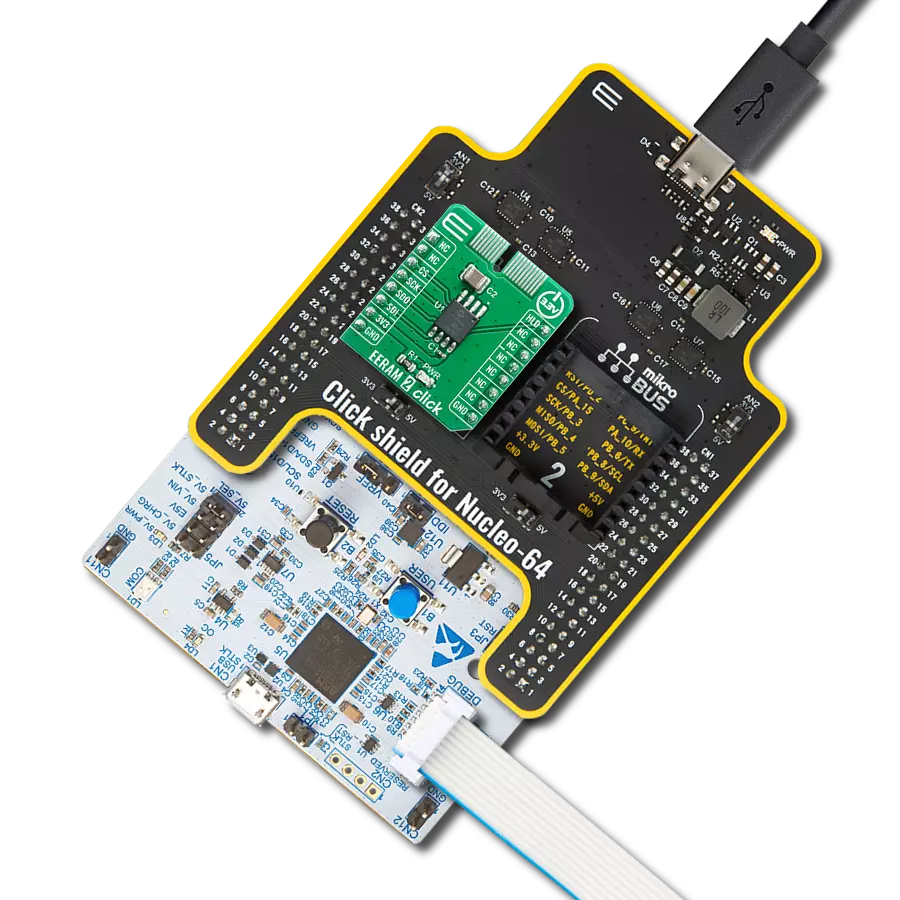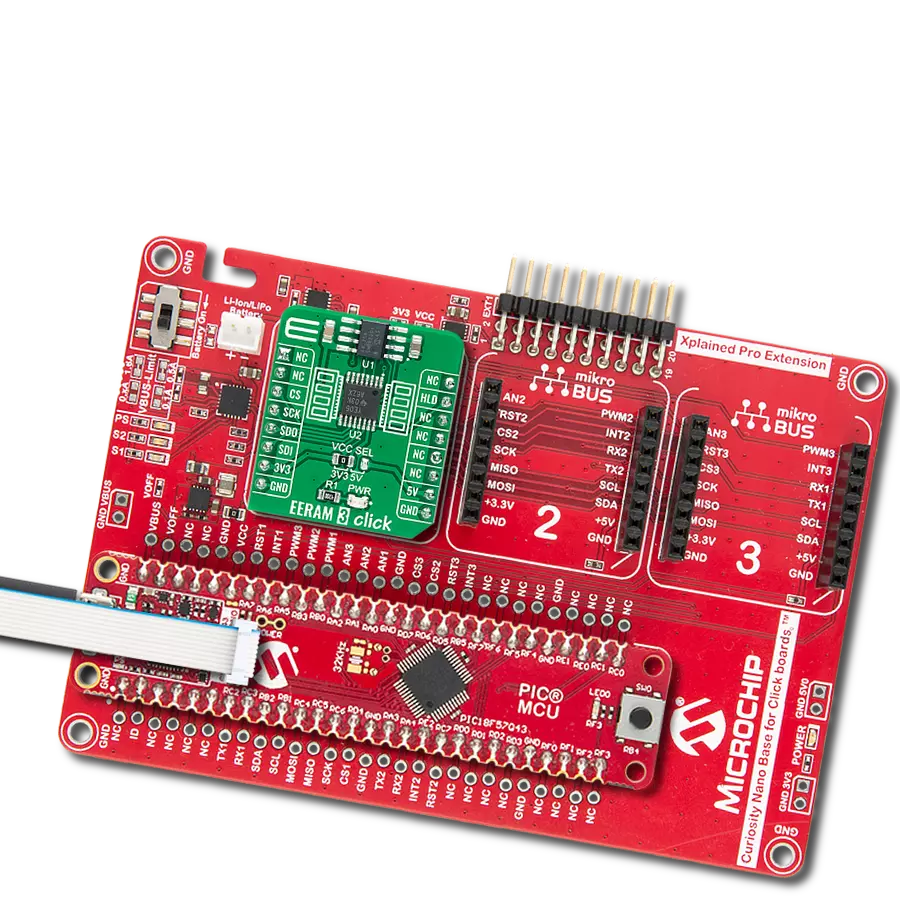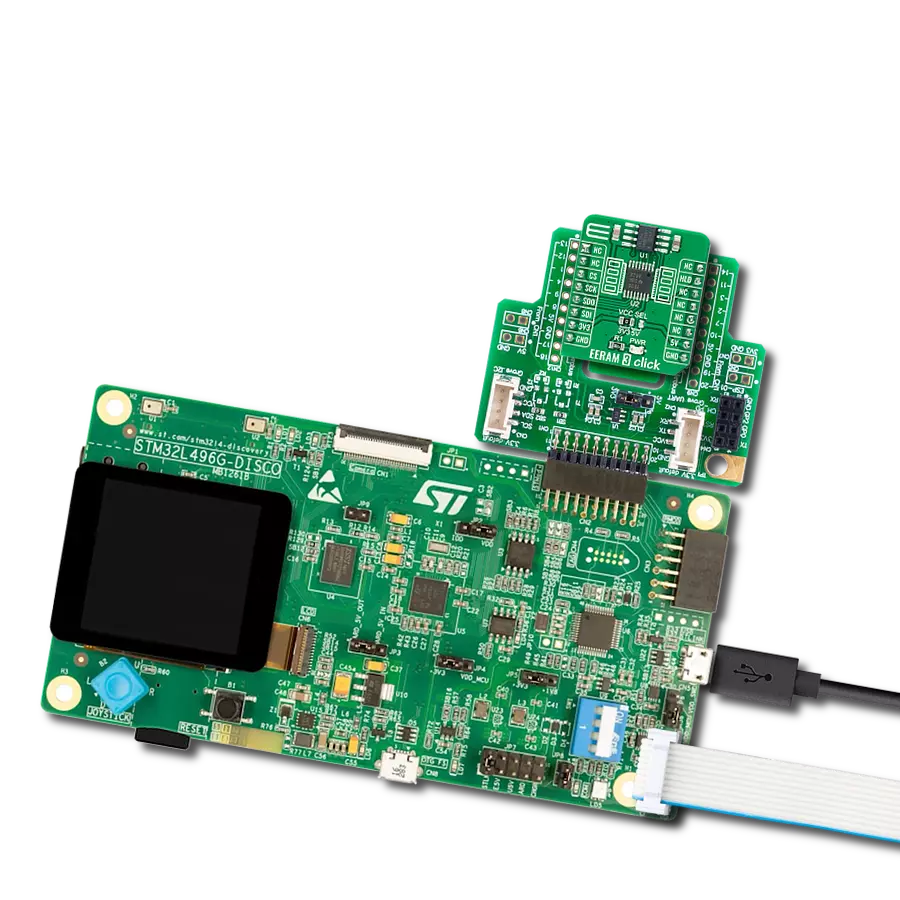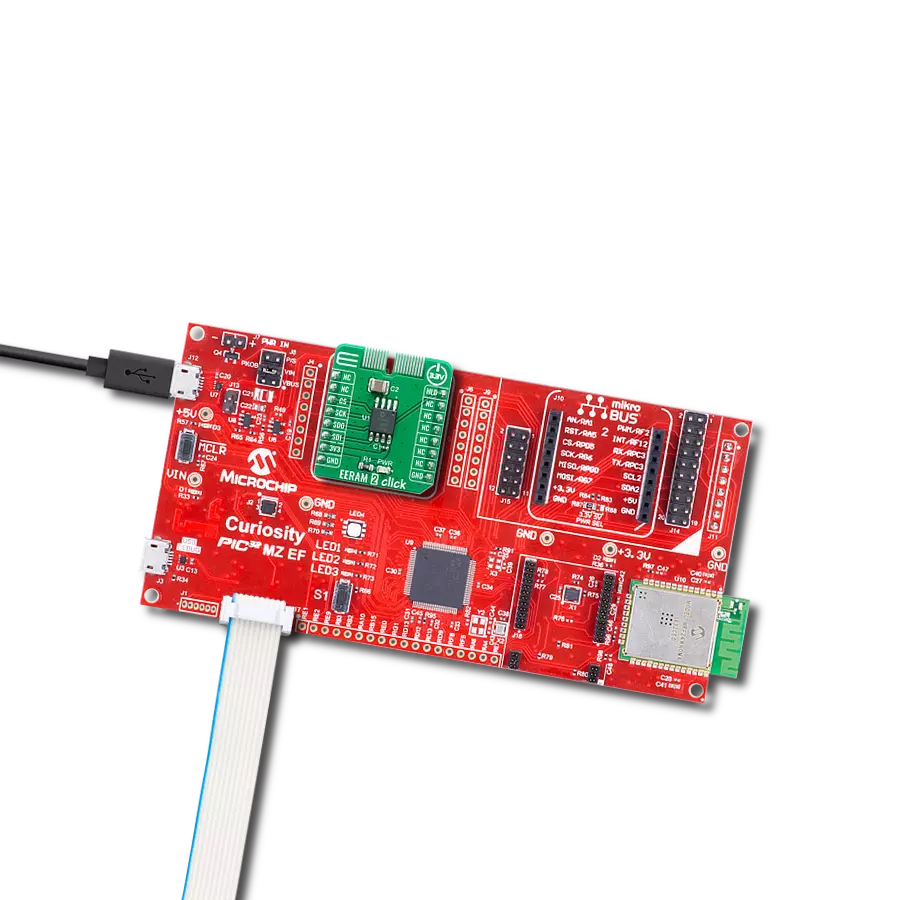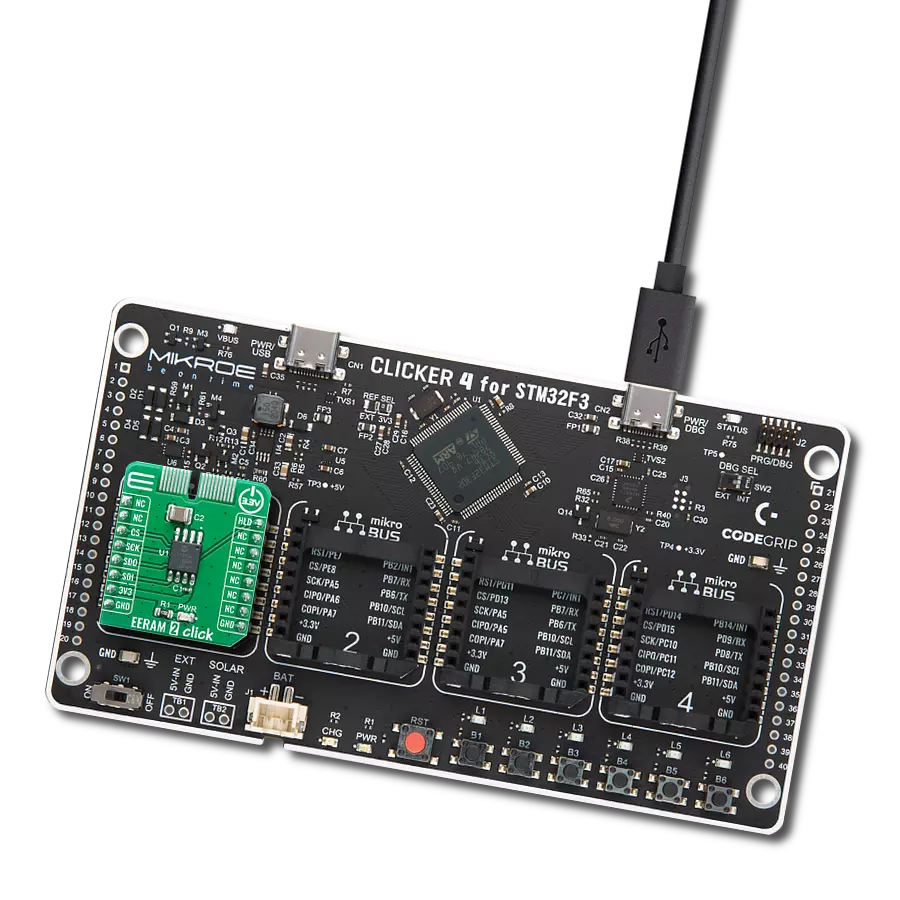Ensure higher protection against unauthorized access by incorporating serial EERAM to store encryption keys, secure boot information, and authentication credentials
A
A
Hardware Overview
How does it work?
EERAM 3 Click is based on the 48L256, an SPI nonvolatile EERAM memory IC designed to retain data when power is disrupted from Microchip. The user can treat this Click board™ as a full symmetrical read/write SRAM: it allows symmetrical reads and writes and has no limits on cell usage. It is structured as a 256-Kbit SRAM with EEPROM backup in each memory cell, where SRAM is organized as 32,768x8 bits. The 48L256 specifies 100.000 endurance cycles with data retention of a minimum of 10 years, which gives the 48L256 the unique capability to handle unlimited reads/writes to the memory. The backup EEPROM is invisible to the user and cannot be accessed by the user independently. The 48L256 includes circuitry that detects VCC voltage dropping below a certain threshold, shuts its connection to the outside environment, and
transfers all SRAM data to the EEPROM portion of each cell for safekeeping. When VCC returns, the circuitry automatically returns the data to the SRAM, and the user’s interaction with the SRAM can continue with the same data set. The 48L256 communicates with MCU through a standard SPI interface that enables very high clock speeds up to 66MHz, supporting the two most common SPI modes - SPI Mode 0 and 3, and a proper logic voltage level conversion performed by the appropriate voltage level translator. The VCC logic level provides a needed reference voltage for one side of the TXB0106, a 6-bit bidirectional level shifting, and a voltage translator with automatic direction sensing from Texas Instruments. On another side of the level shifter, the reference voltage is taken from the 3.3V mikroBUS™ power rail. Another feature of this Click board™
represents the configurable HOLD function labeled as HLD routed on the INT pin of the mikroBUS™ socket. The HLD pin suspends transmission to the 48L256 while in the middle of a serial sequence without re-transmitting the entire sequence. It must be held high any time this function is not being used. Once the device is selected and a serial sequence is underway, the HLD pin may be pulled low to pause further serial communication without resetting the serial sequence. This Click board™ can operate with either 3.3V or 5V logic voltage levels selected via the VCC SEL jumper. This way, both 3.3V and 5V capable MCUs can use the communication lines properly. Also, this Click board™ comes equipped with a library containing easy-to-use functions and an example code that can be used, as a reference, for further development.
Features overview
Development board
PIC32MZ Clicker is a compact starter development board that brings the flexibility of add-on Click boards™ to your favorite microcontroller, making it a perfect starter kit for implementing your ideas. It comes with an onboard 32-bit PIC32MZ microcontroller with FPU from Microchip, a USB connector, LED indicators, buttons, a mikroProg connector, and a header for interfacing with external electronics. Thanks to its compact design with clear and easy-recognizable silkscreen markings, it provides a fluid and immersive working experience, allowing access anywhere and under
any circumstances. Each part of the PIC32MZ Clicker development kit contains the components necessary for the most efficient operation of the same board. In addition to the possibility of choosing the PIC32MZ Clicker programming method, using USB HID mikroBootloader, or through an external mikroProg connector for PIC, dsPIC, or PIC32 programmer, the Clicker board also includes a clean and regulated power supply module for the development kit. The USB Micro-B connection can provide up to 500mA of current, which is more than enough to operate all onboard
and additional modules. All communication methods that mikroBUS™ itself supports are on this board, including the well-established mikroBUS™ socket, reset button, and several buttons and LED indicators. PIC32MZ Clicker is an integral part of the Mikroe ecosystem, allowing you to create a new application in minutes. Natively supported by Mikroe software tools, it covers many aspects of prototyping thanks to a considerable number of different Click boards™ (over a thousand boards), the number of which is growing every day.
Microcontroller Overview
MCU Card / MCU
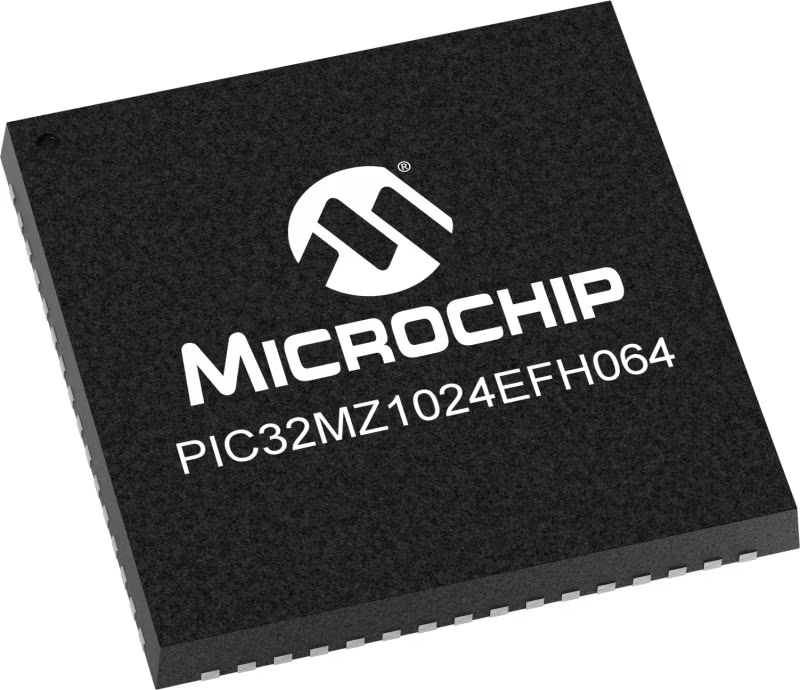
Architecture
PIC32
MCU Memory (KB)
1024
Silicon Vendor
Microchip
Pin count
64
RAM (Bytes)
524288
Used MCU Pins
mikroBUS™ mapper
Take a closer look
Click board™ Schematic

Step by step
Project assembly
Track your results in real time
Application Output
1. Application Output - In Debug mode, the 'Application Output' window enables real-time data monitoring, offering direct insight into execution results. Ensure proper data display by configuring the environment correctly using the provided tutorial.

2. UART Terminal - Use the UART Terminal to monitor data transmission via a USB to UART converter, allowing direct communication between the Click board™ and your development system. Configure the baud rate and other serial settings according to your project's requirements to ensure proper functionality. For step-by-step setup instructions, refer to the provided tutorial.

3. Plot Output - The Plot feature offers a powerful way to visualize real-time sensor data, enabling trend analysis, debugging, and comparison of multiple data points. To set it up correctly, follow the provided tutorial, which includes a step-by-step example of using the Plot feature to display Click board™ readings. To use the Plot feature in your code, use the function: plot(*insert_graph_name*, variable_name);. This is a general format, and it is up to the user to replace 'insert_graph_name' with the actual graph name and 'variable_name' with the parameter to be displayed.

Software Support
Library Description
This library contains API for EERAM 3 Click driver.
Key functions:
eeram3_memory_secure_write- This function securely writes a desired number of data bytes starting from the selected memory addresseeram3_memory_secure_read- This function securely reads a desired number of data bytes starting from the selected memory addresseeram3_set_block_protection- This function sets the block protection bits of the Status register.
Open Source
Code example
The complete application code and a ready-to-use project are available through the NECTO Studio Package Manager for direct installation in the NECTO Studio. The application code can also be found on the MIKROE GitHub account.
/*!
* @file main.c
* @brief EERAM3 Click example
*
* # Description
* This example demonstrates the use of EERAM 3 Click board.
*
* The demo application is composed of two sections :
*
* ## Application Init
* Initializes the driver and performs the Click default configuration.
*
* ## Application Task
* Writes a desired number of bytes to the memory and then verifies that it's written correctly
* by reading from the same memory location and displaying the memory content on the USB UART.
*
* @author Stefan Filipovic
*
*/
#include "board.h"
#include "log.h"
#include "eeram3.h"
#define DEMO_TEXT_MESSAGE "MikroE - EERAM 3 Click board"
#define STARTING_ADDRESS 0x1000
static eeram3_t eeram3;
static log_t logger;
void application_init ( void )
{
log_cfg_t log_cfg; /**< Logger config object. */
eeram3_cfg_t eeram3_cfg; /**< Click config object. */
/**
* Logger initialization.
* Default baud rate: 115200
* Default log level: LOG_LEVEL_DEBUG
* @note If USB_UART_RX and USB_UART_TX
* are defined as HAL_PIN_NC, you will
* need to define them manually for log to work.
* See @b LOG_MAP_USB_UART macro definition for detailed explanation.
*/
LOG_MAP_USB_UART( log_cfg );
log_init( &logger, &log_cfg );
log_info( &logger, " Application Init " );
// Click initialization.
eeram3_cfg_setup( &eeram3_cfg );
EERAM3_MAP_MIKROBUS( eeram3_cfg, MIKROBUS_1 );
if ( SPI_MASTER_ERROR == eeram3_init( &eeram3, &eeram3_cfg ) )
{
log_error( &logger, " Application Init Error. " );
log_info( &logger, " Please, run program again... " );
for ( ; ; );
}
eeram3_default_cfg ( &eeram3 );
log_info( &logger, " Application Task " );
}
void application_task ( void )
{
uint8_t data_buf[ 64 ] = { 0 };
if ( EERAM3_OK == eeram3_memory_secure_write ( &eeram3, STARTING_ADDRESS,
DEMO_TEXT_MESSAGE, strlen ( DEMO_TEXT_MESSAGE ) ) )
{
log_printf ( &logger, "Data written to address 0x%.4X: %s\r\n", ( uint16_t ) STARTING_ADDRESS,
( char * ) DEMO_TEXT_MESSAGE );
}
Delay_ms ( 100 );
if ( EERAM3_OK == eeram3_memory_secure_read ( &eeram3, STARTING_ADDRESS,
data_buf, strlen ( DEMO_TEXT_MESSAGE ) ) )
{
log_printf ( &logger, "Data read from address 0x%.4X: %s\r\n\n", ( uint16_t ) STARTING_ADDRESS,
data_buf );
}
Delay_ms ( 1000 );
}
int main ( void )
{
/* Do not remove this line or clock might not be set correctly. */
#ifdef PREINIT_SUPPORTED
preinit();
#endif
application_init( );
for ( ; ; )
{
application_task( );
}
return 0;
}
// ------------------------------------------------------------------------ END


















